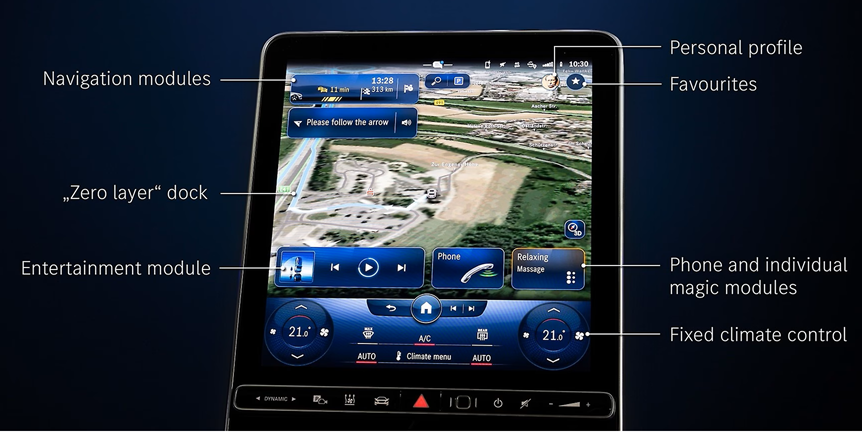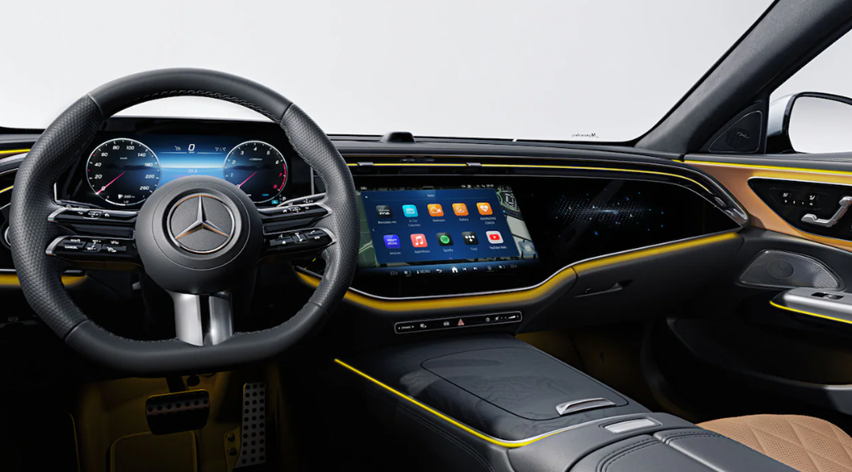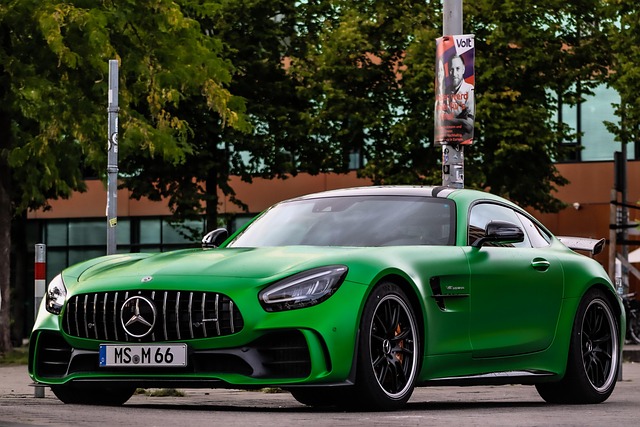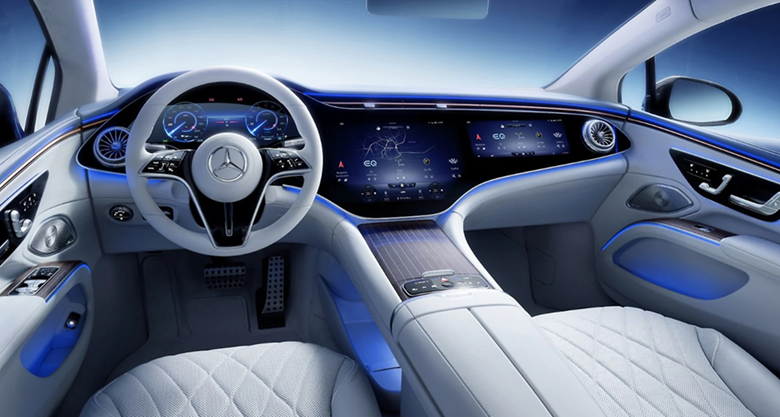MBUX stands for Mercedes Benz User Experience, an AI driven multimedia and infotainment system introduced in 2018 on the Mercedes A Class. It features dual TFT displays (instrument and infotainment), voice assistant, touch and gesture input and integrates smartphone connectivity via Apple CarPlay and Android Auto, real time traffic navigation, ambient lighting controls and natural language voice commands activated with “Hey Mercedes.” The system delivers an intuitive, personalized driving experience by combining artificial intelligence with real-time data.
Table of Contents
Artificial Intelligence inside the Mercedes
Over time, MBUX has evolved to support augmented reality navigation, biometric authentication and over-the-air (OTA) software updates that enhance functionality without the need to visit a dealership. It enables personalized profiles where drivers can save seat position, climate preferences and favorite media settings. These preferences sync seamlessly with the Mercedes me cloud, allowing smooth transitions between vehicles.
With deep learning capabilities, MBUX continuously adapts to user patterns and proactively offers suggestions, such as alternate routes based on daily commute history or queuing a favorite playlist when the vehicle is started at usual times. The system adapts screen layouts with the ‘zero layer,’ which presents dynamic aggregated content from across the MBUX system and its related services at the top level of the interface. Technically, this personalization is powered by embedded neural network models that analyze input from vehicle sensors, voice commands and touchscreen interactions in real time to refine predictions and improve the overall user experience.

MBUX integrates seamlessly with vehicle functions, allowing users to control climate, navigation and entertainment through natural speech or touchscreen input. Each software update expands supported file types, improves responsiveness and deepens system integration. Advanced graphics powered by NVIDIA or Qualcomm chips ensure smooth animations, while the system remains highly responsive to both touch and voice commands. Mercedes has made MBUX a core feature across its lineup, bringing luxury and intelligence to everyday driving.
Multimodal Interaction
MBUX supports multiple input modalities that create a seamless and intuitive user experience. Advanced speech recognition allows the system to understand natural language and contextual commands, for example, saying “I am too cold” can automatically increase the cabin temperature and activate seat heating. The central touchscreen and optional touchpad respond fluidly to driver usage patterns, offering both tactile precision and familiarity for those used to smartphones and tablets.
Gesture control is enabled through MBUX Interior Assist, which uses 3D cameras to detect hand movements and body posture. This enables convenient features such as adjusting ambient lighting or issuing blind spot exit warnings when a hand nears the door handle. The system can even distinguish between driver and passenger gestures by analyzing spatial orientation through stereoscopic imaging.
From a technical perspective, MBUX employs time-of-flight sensors and AI powered pose estimation algorithms to map gesture trajectories in real time, reducing false positives and ensuring accurate, responsive control.
Over‑The‑Air Updates
Later generations are based on MB.OS, integrating generative AI from Microsoft Bing and Google Gemini or ChatGPT4o. This shift delivers a hyper personalized cabin experience with personality modes (natural, predictive, empathetic) that can even detect driver anxiety and trigger comfort actions such as seat massage in response. Mercedes Benz’s software arm Mbition has re architected MBUX with modular design and open-source standards (Wayland composition), enabling faster software upgrades and better resilience.
These OTA updates allow real time deployment of new features such as enhanced navigation algorithms, voice assistant improvements and even dynamic UI changes based on driver behavior. Technically, the use of containerized microservices within MB.OS ensures that system-critical modules remain isolated and secure during updates, significantly reducing the risk of failure and enabling rollback if any anomalies are detected.
MBUX Interior Assist
The MBUX Interior Assist feature uses overhead 3D laser cameras to detect head orientation, eye gaze, hand gestures and occupant body language. It adjusts entertainment settings by sensing hand pointing gestures, allowing users to control volume or skip tracks with simple motions toward the screen or controls. It can also trigger ambient lighting changes when a hand is raised, enhancing the cabin mood or signaling readiness for voice interaction without physical contact.

The system issues pre-emptive blind spot warnings if it detects a hand moving toward the door handle while a vehicle approaches from behind, helping prevent accidental openings. Another key safety feature is detecting a child seat on the front passenger side, prompting a visual and audible warning if the seat belt is not fastened properly.
Online music streaming integrates directly into MBUX, offering millions of songs and linking user profiles across services, with playback controlled via gesture, touch, or voice. For example, when a driver glances at the side mirror and raises a finger slightly, MBUX can interpret this as an intent to adjust the mirror and activate the relevant control automatically. This inference is enabled by multimodal sensor fusion, where inputs from 3D cameras, infrared detectors and proximity sensors are processed together using AI based decision models.
The system also supports predictive gesture recognition, preloading functions based on the trajectory of hand movements before actions are completed to reduce response time. Infrared illumination enhances gesture visibility in low light while maintaining a non-intrusive cabin atmosphere. Dedicated AI accelerators enable real time processing of complex spatial mapping and behavior analysis without compromising infotainment performance.
Screen Innovations in MBUX
Entry level models such as the A Class introduced MBUX with dual 7-inch TFT displays, upgradable to dual 10.25-inch units to create a seamless widescreen panel. Superscreen configurations in higher models like the E-Class and S-Class include a tri screen layout featuring two OLED displays plus a continuous screen that supports rear entertainment, a selfie camera and third-party app streaming such as TikTok, Zoom and casual games.
Hyperscreen setups found in EQS and EQE models extend nearly the full width of the dashboard, powered by eight CPU cores and 24 GB RAM to ensure ultra smooth responsiveness across the instrument cluster, infotainment interface and passenger display. This layout not only enhances multitasking but also introduces features like co-passenger screen lockout when sensors detect the driver is glancing toward it while driving.
The screens use haptic feedback and anti-reflective coatings to ensure visibility in direct sunlight and precise control during motion. Technically, the Hyperscreen incorporates an adaptive brightness control system that uses ambient light sensors and adjusts pixel luminance in real time to optimize clarity and reduce power consumption. The graphical interface is rendered using high performance GPUs, enabling fluid transitions, 3D animations and split screen multitasking without lag.
Safety and Privacy Considerations
MBUX Interior Assist enhances safety by warning drivers before actions such as opening a door into oncoming traffic. It monitors cabin conditions by detecting child seats and seat belt status and automatically adjusts features like door locking, sunblind lowering and air recirculation in advanced models like the S Class W223. These functions rely on environmental sensors and interior cameras working with the vehicle’s central computer to make real time decisions.

Privacy concerns arise because MB.OS collects biometric and behavioral data to personalize the driving experience. Although Mercedes uses fingerprint, face and voice recognition for secure profile access and in car payments, critics worry this sensitive data could be misused or accessed by third parties. For instance, behavioral driving data might affect insurance premiums or be requested by law enforcement under certain laws. Technically, encrypted onboard storage and secure hardware modules protect biometric credentials, but ongoing updates and regulatory compliance are crucial to maintaining user trust.
MBUX is more than an infotainment system; it is a continuously learning, multimodal AI powered digital ecosystem central to Mercedes Benz’s approach to intelligent luxury. It combines natural speech, intuitive gestures, cloud synced profiles and modular software architecture, blending technical prowess with user focused design across the brand’s lineup. By adapting to individual habits through machine learning algorithms, MBUX offers a highly customized driving experience that improves over time without manual input.
For example, it can predict preferred routes based on daily routines or suggest entertainment options aligned with user mood detected through voice tone analysis. The system integrates edge computing for fast local data processing with cloud services for heavy AI updates and cross vehicle synchronization. This balance keeps MBUX robust, secure and constantly evolving through over the air updates, setting a new standard for combining technology, comfort and safety in connected driving.





